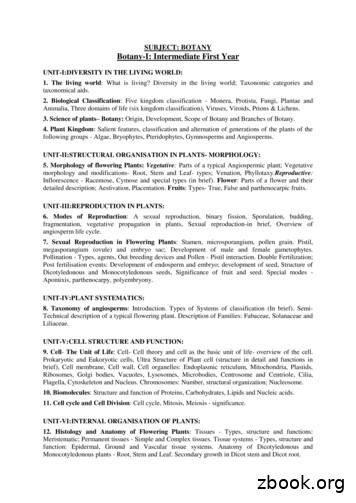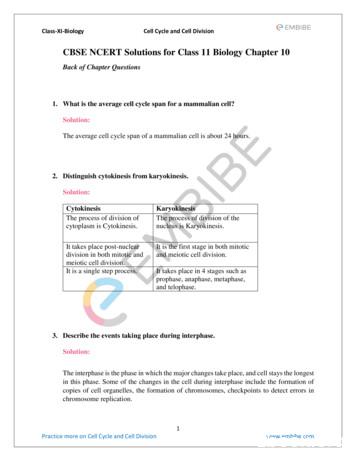Cell Structure And Function - Biology By Napier
Cell Structure and Function I can list the levels of organization in an organismsI can identify types of cells (prokaryotes or eukaryotes) whenlooking at an image or given an exampleI can label prokaryotes and eukaryotes cell structuresI can identify differences in plants, animals, and bacterial cellsI can list cell structures, their functions and indicate where theyare found
The Levels of OrganizationMulticellular organisms are arranged from simple tocomplex according to their level of cellular grouping.celltissueorganorgansystemorganism
Levels of Organization What is the benefit of being made of all of these cells?LevelFunctionOrgansystemDifferent organsfunction togetherOrganDifferent tissuesfunction togetherTissuesCellsSimilar cellsfunction togetherCells can performspecial jobsExampleNervous SystemBrainNervous TissueNeuron
Why study cells? Cells Tissues Organs Bodies bodiesare made up of cells cells do all the work of life!
The Work of Life What jobs do cells have to do for an organism to live “breathe” - respirate eat ATPproteins, carbohydrates, fats, nucleic acidsremove wastescontrol internal conditions ATPbuild molecules take in & digest foodmake energy gas exchange: O2 in vs. CO2 outhomeostasisrespond to external environmentbuild more cells growth, repair, reproduction & development
The Jobs of Cells Cells have 3 main jobs makeenergy needenergy for all activities need to clean up waste producedwhile making energy makeproteins proteinsdo all the work in a cell,so we need lots of them make formore cellsgrowth to replace damaged or diseased cellsOur organellesdo all thesejobs!
Two Types of CellsEukaryotesProkaryote- no organellesplant cells- organellesanimal cellsbacteriacellsfungus cellsprotist cells
4 characteristics of ALL cells (prokaryotes & eukaryotes)All cells have cellmembrane cytoplasm ribosomes nuclear materialnuclearcell membraneribosomescytoplasmmaterial
Cell size comparisonmost bacteriaAnimal cellBacterial cell 1-10 micronseukaryotic cells 10-100 microns micron micrometer 1/1,000,000 meter diameter of human hair 20 microns
Different Types of Cells Prokaryoticno nucleus nonucleusnucleusEukaryoticnucleussmall ribosomes largerribosomes larger ribosomessmall ribosomesnoorganellesorganellesno membranebound organellesmembrane boundorganellesonly in bacteria protists, fungi,protists, fungi,only in bacteriaplants, animalsplants, animals
2 famous EukaryotesPlant cellAnimal cell
Organelles Organelles do the work of cells each structure has a job to do keeps the cell alive; keeps you aliveThey’re likemini-organs!Model Animal Cell
1. Cells make energy Mitochondria Function makeATP energy from cellular respiration O2 ATP fuels the work of life sugar ATPStructure doublemembranein both animal &plant cells
2. Cells need workers proteins! Making proteins torun daily life & growth, the cell must readgenes (DNA) build proteins structural proteins (muscle fibers, hair, skin, claws)enzymes (speed up chemical reactions)signals (hormones) & receptors organellesthat do this work nucleus ribosomes endoplasmicreticulum (ER) Golgi apparatus
endoplasmicreticulumnucleusproteinon its hedproteinproteinGolgiapparatusMaking Proteins
3. Cells need to make more cells! Making more cells toreplace, repair & grow,the cell must copytheir DNA make extra organelles divide the new DNA & new organellesbetween 2 new “daughter” cells organelles nucleus centriolesthat do this work
Cells & Cell OrganellesDoing Life’s Work2009-2010
cytoplasm jelly-like material holdingorganelles in placecell membrane cell boundary controls movementof materials in & out recognizes signals
cytoplasm jelly-like material holdingorganelles in placevacuole & vesicles transport inside cells storagecell membrane cell boundary controls movementof materials in & out recognizes signals
cytoplasm jelly-like material holdingorganelles in placevacuole & vesicles transport inside cells storagecell membrane cell boundary controls movementof materials in & out recognizes signalslysosome food digestion garbage disposal &recycling
Mitochondria Function makeATP energy from cellular respiration O2 ATP fuels the work of life sugar ATPStructure double membraneDNAin both animal &plant cells
cytoplasm jelly-like material holdingorganelles in placevacuole & vesicles transport inside cells storageMitochondria make ATP energyfrom sugar O2cell membrane cell boundary controls movementof materials in & out recognizes signalslysosome food digestion garbage disposal &recycling
Mitochondria are in both cells!!animal cellsplant cellsmitochondriachloroplast
cytoplasm jelly-like material holdingorganelles in placevacuole & vesicles transport inside cells storagelysosome food digestion garbage disposal &recyclingnucleolus producesribosomesNucleus protects DNA controls cellchromosomes DNAmitochondria make ATP energyfrom sugar O2cell membrane cell boundary controls movementof materials in & out recognizes signals
Ribosomes Functionprotein factories read instructions to build proteins from DNA Structuresome free in cytoplasm some attached to ER Ribosomes on ER
cytoplasm jelly-like material holdingorganelles in placevacuole & vesicles transport inside cells storagemitochondria make ATP energyfrom sugar O2cell membrane cell boundary controls movementof materials in & out recognizes signalsLysosome food digestion garbage disposal &recyclingnucleolus producesribosomesnucleus protects DNA controls cellribosomes build proteins
cytoplasm jelly-like material holdingorganelles in placevacuole & vesicles transport inside cells storageLysosome food digestion garbage disposal &recyclingribosomes builds proteinsmitochondria make ATP energyfrom sugar O2cell membrane cell boundary controls movementof materials in & out recognizes signalsnucleus protects DNA controls cellER transport proteins
cytoplasm jelly-like material holdingorganelles in place vvacuole & vesicles transport inside cells storageLysosome food digestion garbage disposal &recyclingribosomes builds proteinsmitochondria make ATP energyfrom sugar O2cell membrane cell boundary controls movementof materials in & out recognizes signalsnucleus protects DNA controls cellER helps finish proteins makes membranesGolgi apparatus finishes, packages& ships proteins
cytoplasm jelly-like material holdingorganelles in placevacuole & vesicles transport inside cells storageLysosome food digestion garbage disposal &recyclingnucleus protects DNA controls cellcentrioles cell divisionribosomes builds proteinsmitochondria make ATP energyfrom sugar O2cell membrane cell boundary controls movementof materials in & out recognizes signalsER helps finish proteins makes membranesGolgi apparatus finishes, packages& ships proteins
nucleus control cell c protects DNAnucleolus make ribosomesendoplasmic reticulum processes proteins makes membranesribosomes make proteinscytoplasm jelly-like materialaround organellescentral vacuole storage: food,water or wasteGolgi apparatus finish & shipproteinscell wall supportmitochondria make ATP incellular respirationcell membrane cell boundary controls movementof materials in & out recognizes signalsandstructurechloroplast make ATP & sugars inphotosynthesislysosome digestion & clean up
Cell Structure and Function. Multicellular organisms are arranged from simple to complex according to their level of cellular grouping. cell tissue organ organ system organism The Levels of Organization. Level Function
animation, biology articles, biology ask your doubts, biology at a glance, biology basics, biology books, biology books for pmt, biology botany, biology branches, biology by campbell, biology class 11th, biology coaching, biology coaching in delhi, biology concepts, biology diagrams, biology
UNIT-V:CELL STRUCTURE AND FUNCTION: 9. Cell- The Unit of Life: Cell- Cell theory and cell as the basic unit of life- overview of the cell. Prokaryotic and Eukoryotic cells, Ultra Structure of Plant cell (structure in detail and functions in brief), Cell membrane, Cell wall, Cell organelles: Endoplasmic reticulum, Mitochondria, Plastids,
Class-XI-Biology Cell Cycle and Cell Division 1 Practice more on Cell Cycle and Cell Division www.embibe.com CBSE NCERT Solutions for Class 11 Biology Chapter 10 Back of Chapter Questions 1. What is the average cell cycle span for a mammalian cell? Solution: The average cell cycle span o
Many scientists contributed to the cell theory. The cell theory grew out of the work of many scientists and improvements in the . CELL STRUCTURE AND FUNCTION CHART PLANT CELL ANIMAL CELL . 1. Cell Wall . Quiz of the cell Know all organelles found in a prokaryotic cell
(Biology-Miller & Levine) & OUHSD Recommended Labs Content Vocabulary Cell Structure 3 weeks Biology/Life Science, Cell Biology: 1c, 1d, 1e, 1f, 1g & 1j* Chapter 7 Cell Microscopy Lab Osmosis Lab 1. Prokaryotic cell 2. Eukaryotic cell 3. Nucleus 4. Cell membrane 5. Semipermeable 6. Phospholipids 7. Hydrophilic 8. Hydrophobic 9. Cytoplasm 10 .
of the cell and eventually divides into two daughter cells is termed cell cycle. Cell cycle includes three processes cell division, DNA replication and cell growth in coordinated way. Duration of cell cycle can vary from organism to organism and also from cell type to cell type. (e.g., in Yeast cell cycle is of 90 minutes, in human 24 hrs.)
Figure 6-17a Essential Cell Biology ( Garland Science 2010) 21. Figure 6-17b Essential Cell Biology ( Garland Science 2010) 22. Figure 6-16 Essential Cell Biology ( Garland Science 2010) 23. 24. 25. Figure 6-19 Essential Cell Biology ( Garland Science 2010) 26.
National 4 Biology Unit 1 Cell Biology Summary Notes. 1. Cell division and it’s role in growth and repair. Cell division The process of cell division is called mitosis. Each cell must divide to ensure the exact same genetic . 6/20/2017 11:00:34 AM .























